If a powerful locomotive is required, and the axle loading gets too great, the obvious solution is to add more wheels to distribute the load. If this is done with a rigid wheelbase it soon becomes impossible to get the machine round curves of a reasonable radius. Most railways took 10-coupled locomotives as the limit, but there were some successful rigid 12-coupled locomotives.
Here I have tried to assemble the complete collection of rigid wheelbase 12-coupled locomotives: moving-axle types, such as the Klien -Lindner Saxon 0-12-0T can be found on other pages. The collection ranges from huge mainline locomotives to small and highly specialised rack locos. It includes- perhaps surprisingly- what was arguably the most advanced steam locomotive ever built; see The SNCF 160-A-1 of 1940 below.
A further extension of the rigid-wheelbase principle to 14-coupled locomotives has only been attempted once, and that appears to have been once too often. See Stalin's Engine
The other approach to adding wheels is to use some form of articulation to give the whole assembly one or more hinges.
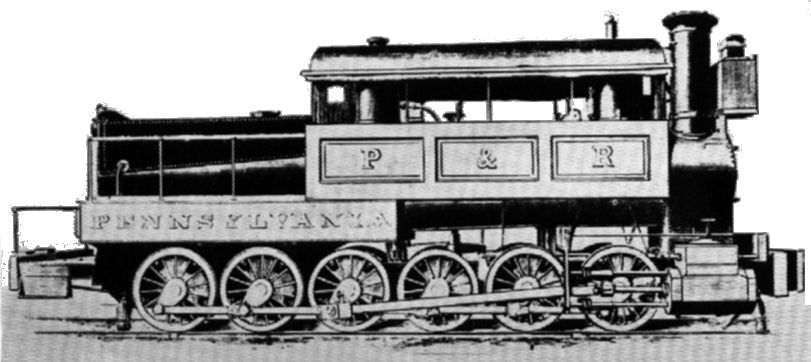
The first 12-coupled locomotive I have been able to discover was "Philadelphia" built in the USA by James Mulholland in 1863, for the Philadelphia & Reading Line. It was an 0-12-0 tank locomotive used for banking duties.
There is no place at the back for the fireman- there was no fireman. The loco was simply stoked up before each banking run.

|
|
1910 2-12-0
The Austrian State Railway S100
Engine weight: 94.25 tons
Coupled wheelbase: 26' 3"
Total wheelbase: 34' 5"
Boiler pressure: 235 psi
No of Cylinders: 4 compound
HP cylinders b x s: 17.75" x 26.75"
LP cylinders b x s: 29.87" x 26.75"
Driver diameter: 4' 9"
Power: 1800 HP
Builder: Florisdorf
| | | | | | | | | | | | | | | | | | | | | | |
|
This was the first European 12-coupled tender engine and was considered the most powerful locomotive in Europe at the time. It was a 4-cylinder compound designed by Karl Gölsdorf, inventor of the Gölsdorf_axle which allowed sideways movement of some of the driving axles. They were built for the Arlberg line which had long 1:40 gradients and a limiting axle-load of 13.8 tonnes. All four cylinders drove the third coupled axle; the HP cylinders were inside the frames.
Twenty locomotives were built. This was Gölsdorf's last compound; the design was not repeated, but it served as the basic model for the The Wurtemberg 2-12-0 of 1917. It gave "full satisfaction" according to André Chapelon and handled curves well; the class was taken out of service in 1927 due to cylinder cracking.
Certain expedients were required to deal with 150 m radius curves:
Leading Bissel truck: 2" of side-play, no centering force.
First axle No side-play
Second axle 1" of side-play, flangeless wheels
Third axle Flangeless wheels
Fifth axle 1" of side-play
Sixth axle 1.5" of side-play
Carden universal joints at each end of the connecting rod between Fifth and Sixth axles
| | | | | | | | | | | | |
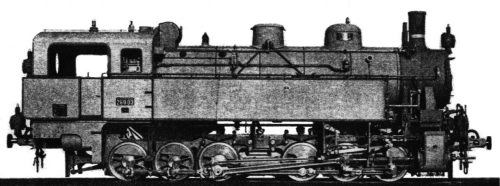
|
|
1912 0-12-0T
The Class 269 Austrian State Railway Zahnradlokomotive
Engine weight: 88 tons
Coupled wheelbase:
Total wheelbase:
Boiler pressure: 13 Bar
Adhesion cyls: Stroke 570 mm
Rack cylinders: Stroke 420 mm
Driver diameter: 1.05 m
Builder: Florisdorf
| | | | | | | | | | | | | | | | | | |
|
The Austrian Erzbergbahn- the rack and adhesion railway over the Erzberg open-cast iron-ore mine- opened in 1891 to transport ore over the Präbichl Pass from the Erzberg to Virdernberg from where it was taken on to the blast furnaces at Donawitz. It was worked by 0-6-2T locomotives (KKStB class 69, then ÖBB class 97) until the end of steam, but for hauling heavier trains over steeper sections, three locomotives of the new Class 269 were delivered in 1913. They were larger, heavier, and more powerful with six coupled axles, ie 0-12-0T, and could handle the steepest gradients with a 170 tonne ore train. One Class 269 (197.301) is preserved as a working locomotive in the Vienna Railway Museum at Strasshof.
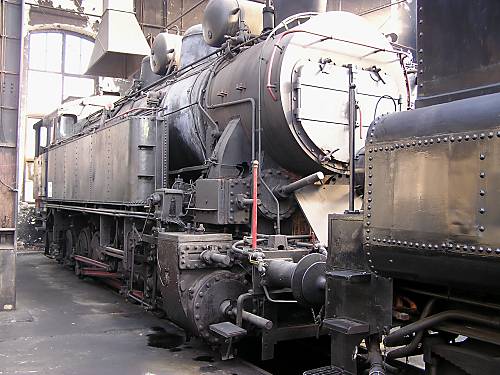 |
| 197.301 at Strasshof
Class 269 was designed by the great Austrian engineer and locomotive designer Karl Gölsdorf, (1861-1916) who was the chief design engineer of the Imperial Royal Austrian State Railways (kkStB) from 1893 to 1916, and who developed 25 different classes of steam locomotive before his untimely death.
The locomotive appears to have grown two cylindrical tanks either side of the steam dome since the above picture was taken. Thomas Edlinger kindly informs me that these are compressed-air tanks for the braking system.
Class 269 locomotives were reportedly popular with their crew on account of their excellent pulling power, but they appear to have been somewhat prone to breaking down, no doubt as a result of the complexity of the dual rack/adhesion machinery. They remained in service to the end of steam operation, the first Class 269 being withdrawn in 1975.
Picture and additional info courtesy of John Ingham
|
The original Austrian class number of this design was 269, but this was changed to 97-3 after the anschluss with Germany in 1938, and again to class 197 when the ÖBB was set up after WW2.
Note that "twelve-coupled" in this case does not include the rack gearwheels. Zahnradlokomotive translates literally as "gear-wheel-locomotive" rather than "rack-locomotive."
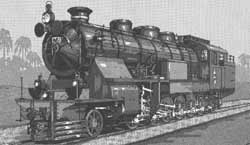 |
|
Left: A Javanic: this 2-12-2T metre-gauge tank locomotive was built for use in Java.
Twelve-coupled locomotives were introduced on the Preanger Mountain Lines of the Java State Railways (Java is now part of Indonesia) after steam-pipe problems with Mallets of various sizes. 28 were built by Hanomag between 1912 and 1920. Although they coped with the work, the tight curves caused severe flange wear on the leading drivers, and they were moved to other mountain lines with milder curves, where they were very successful. Examples were working in Eastern Java up to the early 1970's.
The 2-12-2 configuration is called "Javanic" in the many tables of the Whyte system that have been published, but it is not exactly a word that is on everyone's lips. Two examples (F1002 and F1015) have been preserved in Indonesia, a country that seems to value its historic locomotives; F1002 (formerly SS class 817?) was built in 1915.
|
The series of 2-12-2 locomotives was ordered by the "Javaansche Staats Spoorwegen" (ie the State
Railways of Java) which reported directly to the Dutch Minister of Transport; Java was a Dutch colony at the time. For those for whom God is in the details, the series was numbered 801-823 with subseries:
- JSS 801-810 built by Hanomag 1912/13, build numbers 6450 and 6813-6821
- JSS 811-816 built by Hanomag 1914/15, build numbers 7362-7367
- JSS 817-819 built by Werkspoor 1915, build numbers 372-374
- JSS 820-823 built by Werkspoor 1917, build numbers 418-421
For the railways on the Sumatran West coast an additional five locomotives were buil:
- H 130-132, built by Werkspoor 1915, originally intended as JSS
820-822, build numbers 375-377
- H 133-134, built by Hanomag 1920, build numbers 9353-9354
These last five loco's were shipped directly to Sumatra where they ran
coal trains from the mines in the mountains to the seaports.
 |
| Left: F1002 preserved at Ambarawa Railway Museum in Java. It was built in 1913 by Hanomag. Javanic F1015 is also preserved.
Java, like the German states, has a rich history of unconventional locomotives, and for the same reasons- steep gradients and severe curves. Java boasted Mallets of various sizes, ten-coupled locos partly articulated with Klien-Lindner axles and Luttermöller axles, and rack-and-adhesion locomotives.
The loco had two outside cylinders of 540 x 510 mm. Driving wheel diameter was 1106 mm. Boiler pressure was 12.0 kg/cm2, The weight was 78.7 tons, of which 62.3 tons were available for adhesion.
Despite being a twelve-coupled design, this locomotive is not enormous. Remember it was built for the old 3ft 6in (1067 mm) "Cape gauge" much used in South Africa, and not the standard 4ft 8.5in.
|
Some technical details:
Cylinder diameter: 540 mm
Piston stroke: 510 mm
Wheel diameter: 1102 mm for coupled axles, 774 mm for the pony trucks
Overall length: 13.88 m
Boiler diameter: 1.40 m
Boiler length: 7.268 m
Boiler height (centreline): 2.45 m above railhead
Fixed wheelbase: 3.75 m, other driving wheels slide sideways, pony trucks
are pivoted
Overall wheelbase: 10.25 m
Max. width: 2.506 m
Max. heigth: 3.70 m
Max speed: 55 km/h, later upgraded to 75 km/h. On trials 85 km/h.
Min. radius on curves: 140 metres
Gauge: 1.067 m (3ft 6in)
| | | | | | | | | | | | | | | | | | | | | | | | | | | |
 |
| Left: Another view of F1002 at Ambarawa Railway Museum.
Later locomotives in this series were built by Werkspoor.
Colour pictures by kind permission of Rob Dickinson.
Original photography by Nick Bryant.
Further information on the Javanics would be most welcome.
|
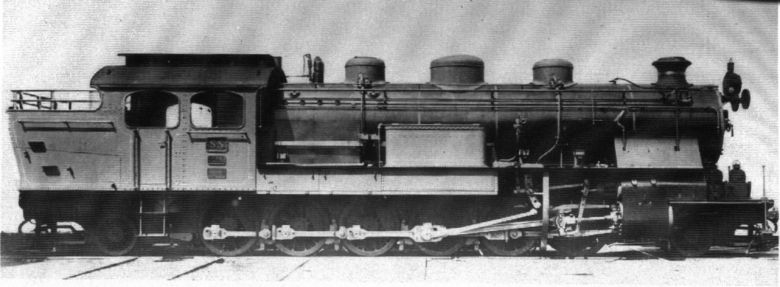
Above: Side view of Javanic F1018. (Originally SS No 818) This is a Werkspoor version, built in 1915.
For much more on steam locomotives in java see Rob Dickinson's excellent site at: http://dialspace.dial.pipex.com/javatour/trains/pnkapres.htm
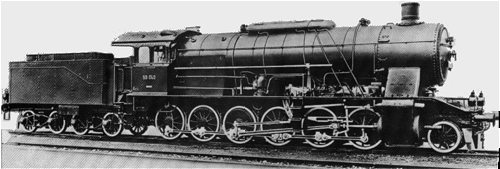 |
|
1917 2-12-0
Wurtemberg State Railway Class K locomotive
Engine weight: 108 tons
Coupled wheelbase:
Total wheelbase:
Boiler pressure: 213 psi
No of Cylinders: 4
HP cyls b x s: 20" x 25.5"
LP cylinders b x s: | | | | | | | | | | | | | | | | |
|
44 of these superheated four-cylinder compound locomotives were built between 1917 and 1924. The inside HP cylinders drove the third coupled axle, while the outside LP cylinders drove the fourth. They were a succesful design, being reliable and powerful, and economical on severe gradients, though less so on the level. They became Class 59001/44 of the Deutsche Reichsbahn.
Once again, there were certain expedients, this time to deal with curves of 105 m radius:
First axle 20mm of side-play (Golsdorf system)
Second axle No information: presumably standard
Third axle Flanges thinned by 15mm
Fourth axle Flanges thinned by 15mm
Fifth axle No information: presumably standard
Sixth axle 45mm of side-play, spring lateral control when 28mm exceeded (Golsdorf system)
| | | | | | | | | | | |
The Golsdorf system allowed the front and rear axles to slide sideways on curves, the inner axles being fixed.
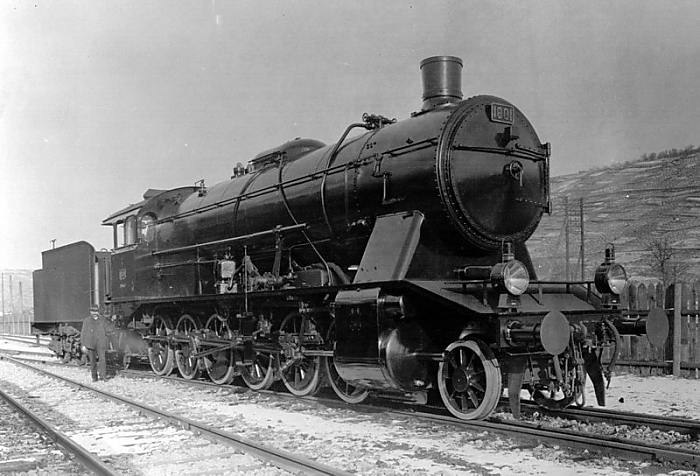 |
| Wurtemberg State Railway Class K locomotive
The Class K were built for work on the Geislingen ramp and the Baden Black Forest line. These routes had severe gradients, and a maximum axle load of only 16 tonnes, so a 12-coupled design was produced. Later, when these lines had been taken over by the Deutsche Reichsbahn, the track was upgraded for greater axle loads, and the work could be handled by 10-coupled locomotives; therefore no more Class K were ordered.
|
 |
|
Above: Wurtemberg State Railway Class K locomotive: 1919
Picture from the leading article in the German journal Die Lokomotive for January 1919
|
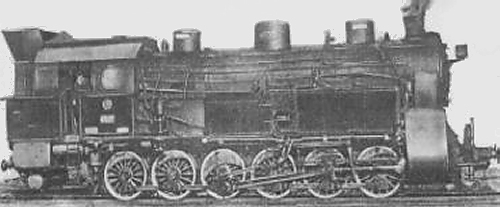 |
|
The Bulgarian State Class 45
Class 45:00 were, apart from the number of wheels they had, standard gauge 2-cylinder compounds. They were not entirely satisfactory, being unstable on the track.
|
Engine weight: 101 tons
Length: 14.4 m
Coupled wheelbase: 7.225 m
Grate area: 4.6 m2
Evaporative area: Original: 248.4 m2.
Rebuilt: 181 m2 + superheat area 75 m2 = total heating area 256 m2
Boiler pressure: 15 bar ( psi)
No of Cylinders: 2
Left cylinder: LP 900mm diam (Original)
Right cylinder: HP 620mm diam
Piston stroke: HP 700mm
Driver diameter: 1340 mm
Fuel & water: Coal 5 ton, water 12 m3
Max speed: 45 km/h
Builder: Hanomag
|
| | | | | | | | | | | | | | | | | | | | | | | | | | | | |
The arrangements for getting round curves were as follows:
The 1st axle had 28 mm of transverse movement.
The 2nd and 5th axles had no transverse movement, defining the fixed wheelbase.
The 3rd axle had 15 mm of transverse movement.
The 4th axle had flangeless wheels.
The 6th axle had 28 mm of transverse movement.
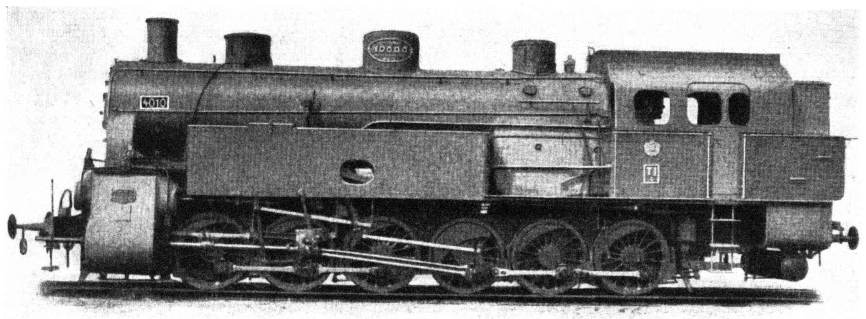 |
| Left: Bulgarian State Class 45: 1922
Note the build number 10,000 on the steam dome. This example was completed on the 15th of July, 1922.
|
After WW2 they were transformed into 2-cylinder simple expansion locomotives, with two 620mm cylinders. This increased the tractive effort from 15.3 tons to 22.6 tons. They were reconstructed in 1948 with Lentz poppet valves and Schmidt superheaters.
Technical information kindly supplied by Johannes Laeubli

 |
|
1926 4-12-2
The Union Pacific Class 9000
Engine weight: 224.5 tons
Coupled wheelbase:
Total wheelbase:
Boiler pressure: 220 psi
No of Cylinders: 3
Inside cylinder: 27" x 31"
Outside cylinders: 27" x 32"
Driver diameter: 5' 7"
Power output: 4750 HP
Tractive effort: 96,650 lbs
Builder: Alco
NB: There is some doubt about the cylinder dimensions.
| | | | | | | | | | | | | | | | | | | | | | | | | |
|
These were the heaviest rigid steam locomotives produced in the USA; 88 were built for the UP by ALCO between 1926 and 1930. The original intended speed had been a modest 35 mph, but they proved stable up to 60 mph. After only ten years of main-line freight service in Oregon, Wyoming and Utah, these locomotives were relegated to slower operations in Nebraska, being displaced by Challengers and Big Boys.
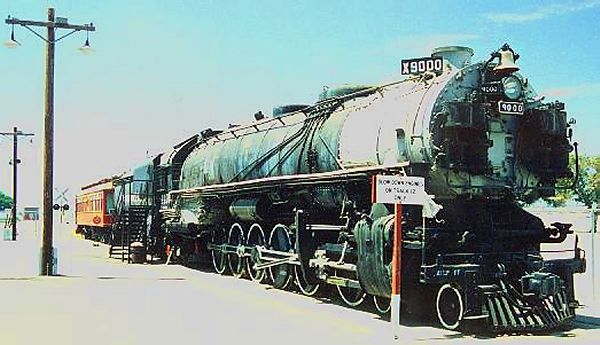 |
| Left: The preserved 9000 at the Los Angeles County Fairplex
|
One of these locomotives has been preserved at "The Los Angeles County Fairplex", the home of the Southern California Chapter of the Railway & Locomotive Historical Society. It is known as No 9000, so it appears to be the first member of the class. It arrived at the museum in May 1956 under its own power. This locomotive is said to have been in use for nearly 30 years, mainly between Green River, Wyoming and Council Bluffs, Iowa.
The inside cylinder drove the second coupled axle, and the outside cylinders the third. Kratville and Ranks give the weight including tender as 403.5 tons.
The 4-12-2 configuration became known as the "Union Pacific" wheel arrangement, because it was unique to UP. The locomotives were added to the UP roster as follows:
Year How manyNumbers
1926 15Nos 9000-9014.
1928 23 9015-9029 (15 locomotives), 9055-9062 (8
locomotives)
192925 9030-9054
193025 9078-9087 (10 locomotives), OSL 9500-9514 (15
locomotives)
Total 88
| | | | | | | | | | | | | | | | |
As to why the locomotives were numbered out of sequence, I have no idea.
The Union Pacific Class 9000 has a Wikipedia page.
 |
| Left: The preserved 9000: another view
|
 |
|
1940 2-12-0
The SNCF 160-A-1 Six-cylinder Reheat Locomotive
Engine weight: 135.35 tons
Coupled wheelbase: 27' 4"
Total wheelbase: 35' 4.5"
Boiler pressure: 260 psi
No of Cylinders: 6
HP cylinders b x s: 520 x 540 mm
Outside LP cyls b x s: 640 x 650mm
Driver diameter: 1.4m
Builder: SNCF
| | | | | | | | | | | | | | | | | | | | |
|
This remarkable locomotive deserves a website to itself. Its features included six cylinders and reheat.
It was a rebuild of a Class-6000 2-10-0 by the great Andre Chapelon, for the Paris-Orleans Railway.
Steam from the boiler passed through a 39 element Houlet superheater, and then to the two HP cylinders inside the frames which drove the fourth coupled axle. Steam leaving these passed through the reheater, which was essentially a Schmidt superheater with 68 elements. Two of the LP cylinders were also inside and drove the second coupled axle; the outside LP cylinders drove the third coupled axle. All cylinders had steam jackets. The various cranks were aligned to give six beats per revolution, smoothing the driving torque. Lentz oscillating-cam poppet valves were fitted.
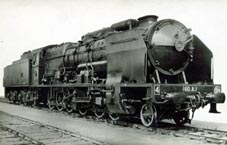 |
| Left: another view of the 160-A-1
The 160-A-1 was completed at the Tours works in 1940, but was not tested until 1948 due to WW2. It was extremely successful, according to M. Chapelon in his great book "La Locomotive A Vapeur", though it is just possible he was not completely impartial. It was however the last European 2-12-0 locomotive.
The 160-A-1 was a 'flying test-bed' and never intended for production. It was to provide data for a series of less complex locomotives with six cylinders; Chapelon published outline plans for these but none were built. The 160-A-1 was tragically scrapped in November 1955
|
The 160-A-1 has a Wikipedia page, but it is in French.
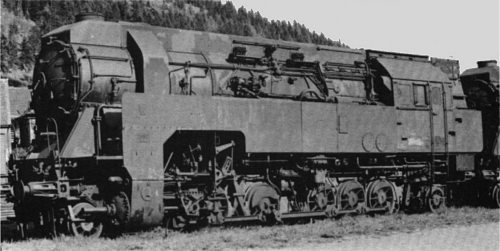 |
|
1941 2-12-2T
The Austrian Federal Railway Class 97.
Rack and adhesion system
Engine weight: 123.6 tons
Coupled wheelbase: 22' 10"
Total wheelbase: 37' 7"
Boiler pressure: 227 psi
Adhesion cylinders: 24" x 20.5"
Rack cylinders: 15.75" x 19.7"
Driver diameter: 3' 5.5'
Builder: Lokomotivfabrik Florisdorf
| | | | | | | | | | | | | | | | | | | |
|
Two of these locomotives, the heaviest and most powerful steam rack locomotive ever built, were delivered in 1941 for use on the Austrian Erzbergbahn.
The engine has two pairs of cylinders, giving separate drive to the adhesion and rack driving wheels. They were capable of hauling a 300 tonne train up the steepest section of track at 15 km/h, compared with 10-11km/h for the Class 269 with a 170 tonne load. However they were withdrawn early as they were unreliable and susceptible to derailment, due to vibration problems. The first locomotive (Number 297.402) was withdrawn in May 1949 and used for spares to keep the other (297.401) running. It was used less and less, rarely venturing beyond the Vordernberg shunting yard or the adhesion-only line down to Donawitz. It was last used in service in 1964 but was not officially withdrawn until 1968. 297.401 is now plinthed at Voredernberg-Markt station in Austria.
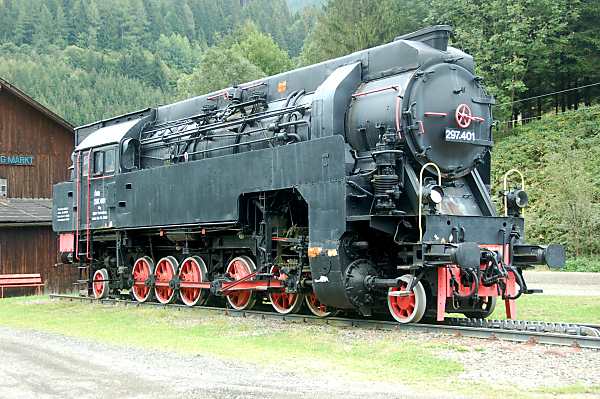 |
| Left: A 297.401 displayed at Vordernberg Markt
The rack can be seen at the front of the loco, between the rails.
Photo kindly provided by John Ingham
|
 |
| Left: 297.401 displayed at Vordernberg Markt
Rear view. Note the windows at the rear of the cab for running in reverse. They are heavily cowled to keep snow off the glass.
Photo kindly provided by John Ingham
|
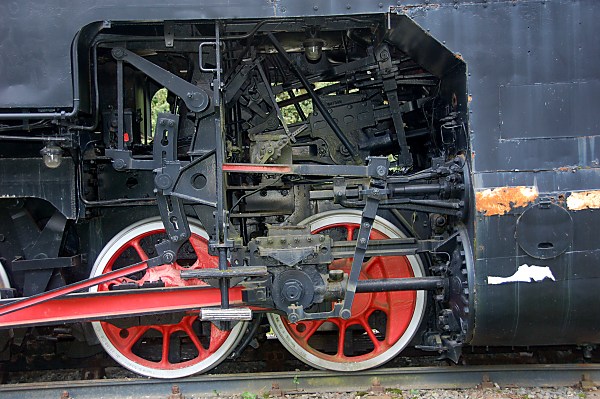 |
| Left: 297.401 displayed at Vordernberg Markt
The complex mechanism of a combined rack and adhesion locomotive. Maintenance was difficult because of the extreme inaccessibility of the rack mechanism on the inside.
Drive to the rack cog was via 1:2 reduction gearing.
Photo kindly provided by John Ingham
|
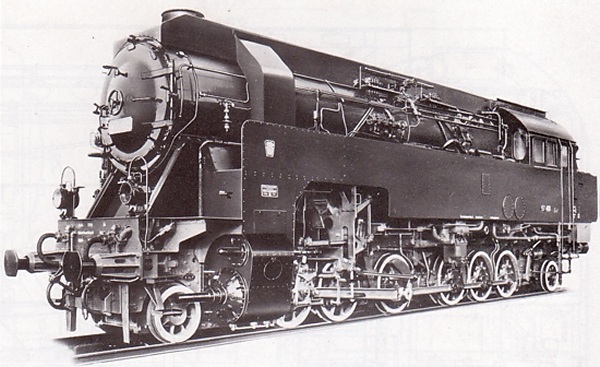 |
| Left: Manufacturer's photograph of a Class 97
I wonder about the economics of this project. Only two examples were built, and it seems unlikely that there were expectations of large sales elsewhere for such a specialised locomotive. No doubt standard parts were used wherever possible, but there surely must still have been an enormous amount of design work to do. Unless they charged a fortune for each locomotive it's hard to see how Lokomotivfabrik Florisdorf could have made a profit.
But then of course it was 1941, and the normal rules of economics were somewhat laid aside.
|
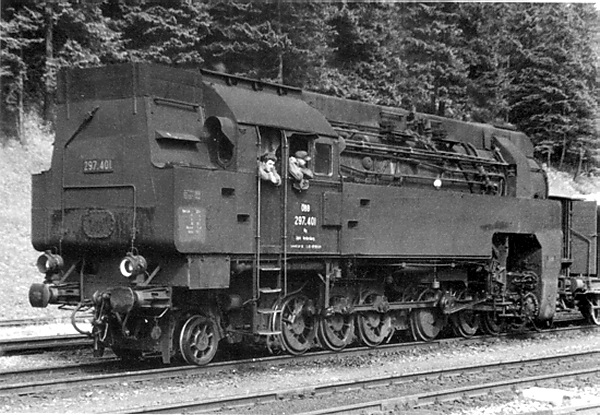 |
| Left: 297.401 at work in the early 60s
Exact location currently unknown.
|
 |
| Left: A closer look at the daunting complexities of the 297 motion-work
|
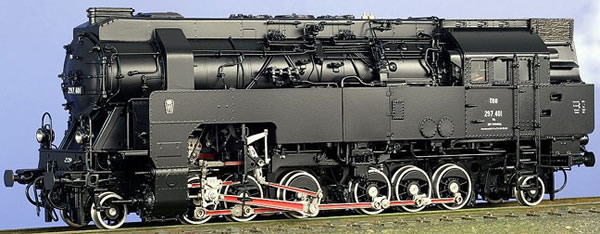 |
| Left: Superb model of 297.401 by Micro Metakit
This model features a completely functional inner rack system and will run with both drive systems like the prototype. The outer drive rods turn slowly and the inner rods spin twice as fast to move the rack gears. A remarkable bit of work.
In HO scale. The Price: $2,495.00
|
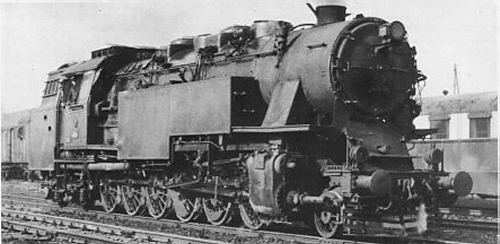 |
|
1938/1942 2-12-4T
The Bulgarian State Class 46
The data just below apply to both batches.
|
| Boiler pressure: 16 bar ( psi)
Grate area: 4.87 m2
Fuel & water: Coal 10 ton, Water 18 m3
Driving wheel diameter: 1340mm
Lead/trail wheel diam: 850mm
Max speed: 65 km/h
|
| | | | | | | | | | | | | | | | |
|
Apart from the number of axles, this design was a standard gauge superheated simple-expansion locomotive. The 3rd and 4th axles had flangeless wheels. They were designed to haul heavy coal trains on steep mountain gradients (up to 1 in 35.7 and more) which they did very successfully. Bulgarian railwaymen called them "Mother Bear". These engines appear to be the most powerful steam locomotives built in Europe. Remarkably, it appears that two examples, 46.03 and 46.13, have been preserved.

|
Above: Side view of the Bulgarian State Class 46. Regrettably not a lot of detail is visible at this scale
|
Note the upward angle of the valve spindles shown here.
From the German journal Die Lokomotive for November 1943
Two batches of the locomotives were built, with some significant differences.
The first batch of 12 was built in 1931 by Cegielski Poznan (a company in Poland) as 4 501 - 512; from 1936 46 01 - 12 (Builder nos: 201 - 212). These had two cylinders of 700 mm diameter. Here are the details:
Engine weight: 149.1 metric tons
Adhesion weight 101.7 tons
Axle Load: Drivers: 17 tons
Coupled Wheelbase: 8 m
Total Wheelbase: 14,5 m
Total length: 18.205 m
Piston stroke: 700mm
Evaporation area: 224 m2 + superheating area 84 m2 = total heating area 308 m2
Tractive effort: 30.67 tons
| | | | | | | | | | | | | | | | | |
 |
| Left: Drawing of the Bulgarian State Class 46 as built by Cegielski
|
The second batch of 8 was built by Schwartzkopff Berlin as 46 13 - 20 (Builder nos: 11794-11801) These had three cylinders of 550 mm diameter. Here are the details:
Engine weight: 155.8 metric tons
Adhesion weight 108 tons
Axle Load: Drivers: 18 tons
Coupled Wheelbase: 7.85 m
Total Wheelbase: 14.45 m
Total length: 18.155 m
Piston stroke: 650mm
Evaporation area: 224 m2 + superheating area 82 m2 = total heating area 306 m2
Tractive effort: 26.4 tons
| | | | | | | | | | | | | | | | | |
Although there were major design differences between the two batches they were both put into Class 46.
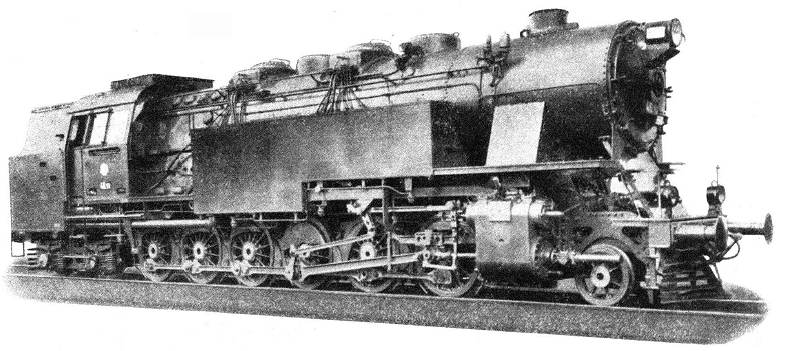
|
Above: The Bulgarian State Class 46. This is believed to be a manufacturer's photograph of the version built by Schwartzkopff
Here the valve spindles are horizontal.
From the German journal Die Lokomotive for November 1943
|
Technical information on these locomotives kindly supplied by Johannes Laeubli and Kerry Stiff
THE GENERAL BELGRANO RAILWAY CLASS E24: 1955 0-12-2T
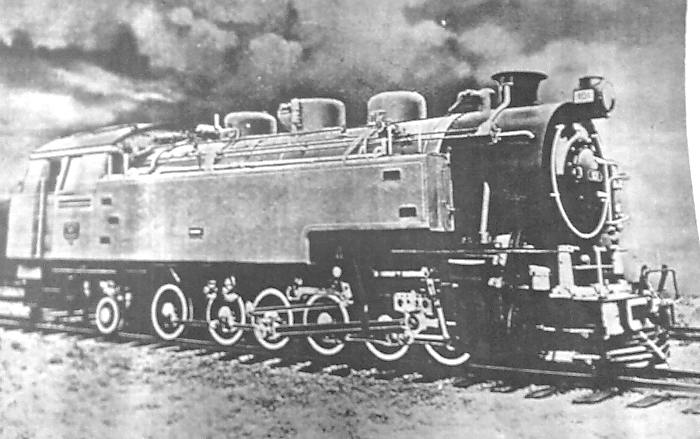 |
| Left: The Belgrano Railway Class E24
Two metre-gauge rack and adhesion oil-fired locomotives were built by Maschinenfabrik Esslingen in 1955 for the General Belgrano Railway in Argentina. They were 0-12-2T tank engines known as Class E24. They were modern and well-designed locomotives but too complex for the facilities of the line, and spent too much time out of action with cracked frames and cylinders. They were relegated to stationary boilers as soon as diesels arrived.
The new locomotives replaced three 0-8-2 rack-and-adhesion locomotives (also built by Esslingen) that had been working since 1905- ie for no less than 50 years.
|
Driver diameter 37in
Cylinders Diameter x Stroke 26.75x19.5 in
Boiler Press200psi
Adhesion weight99 tons
Total weight WO110 tons
Grate Area38sq.ft
Evaporation Surface2280sq.ft
Suprheater Surface930sq.ft
| | | | | | | | | | | | | | | |
|
| The rack wheels were driven by 2.44:1 ratio gearing from separate outside cylinders of dimensions 15.75 x 15.75in.
Wikipedia has a comprehensive list of locomotives classified by wheel arrangement. Interestingly, 0-12-2 is not included.
|
 |
| Left: The Belgrano Railway Class E24
This diagram shows two rack wheels (dotted) with the wheels above them which were driven by the rack cylinders.
The adhesion weight was 99 out of 110 tons (in working order) which was pretty good going.
|
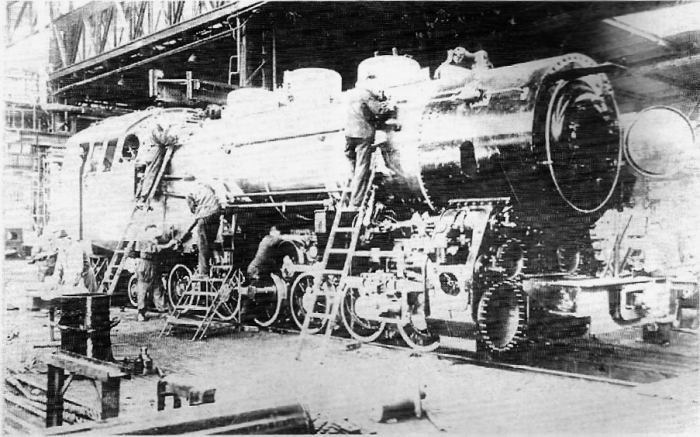 |
| Left: Class E24 under construction
One of the Class E24's under construction in the Maschinenfabrik Esslingen workshops.
Image quality is not good but the big cylinder for the adhesion drive and the smaller inboard cylinder for the rack drive can be clearly seen. Next to each cylinder is its valve assembly.
|
Googling "Belgrano" tends to bring up references to this incident. Both the ship and the railway were named after Manuel Belgrano, one of the leaders in the Argentine Wars of Independence.









































